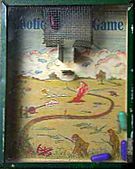The Game of Cootie facts for kids

Original box cover and game components, 1949
|
|
| Designer(s) | William H. Schaper |
|---|---|
| Publisher(s) | Hasbro |
| Publication date | 1949 |
| Players | 2 to 4 |
| Setup time | 2-4 minutes |
| Playing time | 10-20 minutes |
| Random chance | Entirely |
| Skill(s) required | Matching |
The Game of Cootie is a children's dice rolling and set collection tabletop game for two to four players. The object is to be the first to build a three-dimensional bug-like object called a "cootie" from a variety of plastic body parts. Created by William Schaper in 1948, the game was launched in 1949 and sold millions in its first years. In 1973, Cootie was acquired by Tyco Toys, and, in 1986, by Hasbro subsidiary Milton Bradley. The game was given a new look and continued to enjoy commercial success. Several companies published cootie games in the first half of the twentieth century, but only Schaper's featured a free-standing, three-dimensional cootie. In 2003, Cootie was named to the Toy Industry Association's "Century of Toys List".
It is based on the traditional dice game Beetle.
Contents
Game play
The object of the original 1949 game is to be the first player to build a "cootie" piece by piece from various plastic body parts that include a beehive-like body, a head, antennae, eyes, a coiled proboscis, and six legs. Body parts are acquired following the player's roll of a die, with each number on the die corresponding to one of the body parts. The body corresponds to one, the head to two, three to the antennas (feelers), four to the eye, five to the proboscis (mouth), and six to the leg. The first part to be acquired must be the body, and then the head. All other body parts may then be acquired in any order. When a player acquires a part, an additional throw of the die is allowed in an attempt to acquire another part. The winner is the first player to completely assemble a cootie.
Etymology
The earliest recorded use of the word "cootie" appears in Albert N. Depew's World War I memoir, Gunner Depew (1918): "Of course you know what the word 'cooties' means....When you get near the trenches you get a course in the natural history of bugs, lice, rats and every kind of pest that had ever been invented." The word may be derived from Malaysian kutu, a head louse. In North American English, children use the word to refer to a fictitious disease or condition, often infecting members of the opposite sex. Among children, the word effectively serves as a device for enforcing separation of the sexes.
Other cootie games
Schaper's game was not the first based upon the insect known as the "cootie". The creature was the subject of several tabletop games, mostly pencil and paper games, in the decades of the twentieth century following World War I. The Cootie Game fashioned by the Irvin-Smith Company about 1915 was a hand-held game that involved tilting capsules into a trap over a background illustration depicting a WWI battlefield.
In 1927, the J. H. Warder Company of Chicago released Tu-Tee, and the Charles Bowlby Company released Cootie; though based on a "build a bug" concept similar to Schaper's, both were paper and pencil games. In 1937, Rork's released The Game of Cootie, and it too was a paper and pencil game. A paper and pencil party game called Beetle is popular in Britain, and dates from the mid 1940s or earlier.
In 1939, Transogram published Cootie, a game featuring a three-dimensional wooden bug assembled in a die-cut tray. Schaper's game was the first to employ a fully three-dimensional, free-standing plastic cootie.
Legacy
Schaper's plastic bug has become an icon, and, for some, a symbol for the baby boomer generation. In 2003, the Toy Industry Association included Cootie on its "Century of Toys List" of the 100 most memorable and most creative toys of the 20th century.


